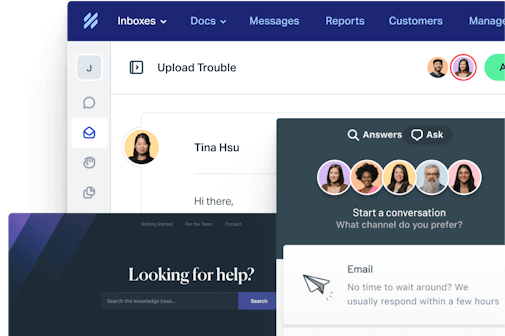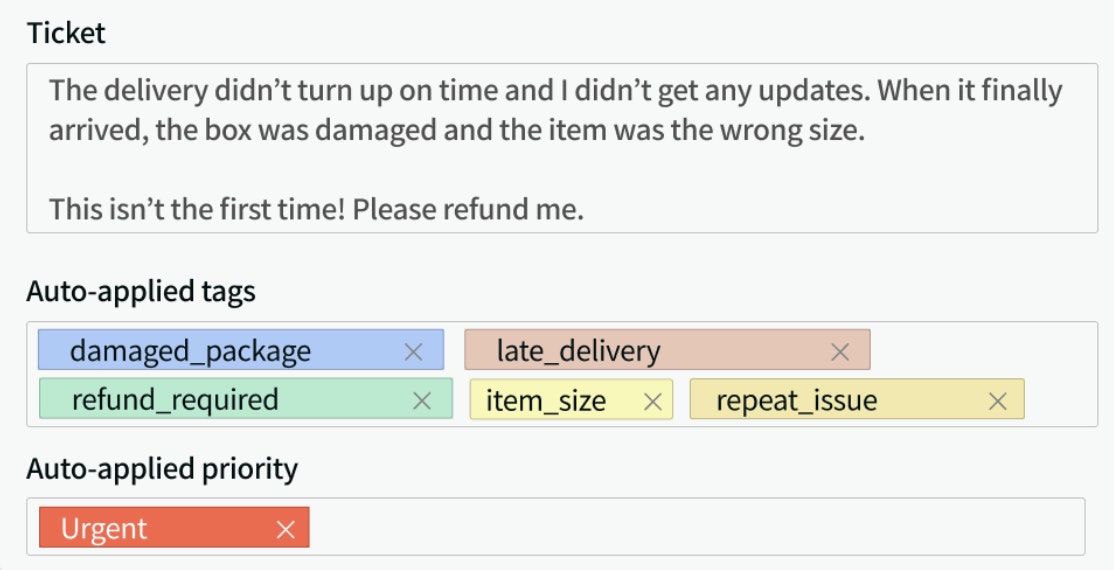Wondering if your customer service team is meeting expectations? You're not alone. As data-driven practices become the norm, many leaders are turning to customer service analytics to shed light on their team's performance and uncover areas for improvement.
Whether it's response times, customer satisfaction scores, or the frequency of certain issues, tracking customer service metrics gives you a quantifiable measure of your customer service success. These analytics can help you identify bottlenecks, understand customer behavior, and, most importantly, improve customer satisfaction — a key building block for customer loyalty and growth.
In this article, we'll take a closer look at these analytics, their importance, and how you can leverage them to elevate your customer service. Remember, you're not just aiming to understand the data; you're unlocking the potential to transform your business's customer service experiences.
What are customer service analytics?
Customer service analytics are the systematic analysis of customer service data to inform decision-making and improve customer interactions. Think of them as sifting through the vast ocean of customer service interactions to find pearls of insight. These analytics draw from various sources like support tickets, customer feedback, and service times to help paint a comprehensive picture of how your team is performing.
The role of analytics in providing effective customer service
Imagine being able to predict the needs of your customers before they even have to ask or being able to identify small issues before they turn into bigger problems. That's the power of customer service analytics. They’re not just about reacting to what's already happened; they’re proactively improving your service for the future.
By understanding the why and how behind customer interactions, you can:
Pinpoint areas for improvement. Analytics can highlight inefficiencies or problems in your current support system, allowing you to make targeted changes.
Tailor your customer experience. By analyzing customer behavior and feedback, you can create a more personalized service that meets individual needs.
Enhance customer satisfaction. Ultimately, analytics are about ensuring a smoother, more efficient service that leaves your customers feeling valued and understood.
Customer service analytics act as the bridge between you and your customers, helping you understand their experiences better. With these insights, you can create a strategy that not only meets their expectations but exceeds them, ensuring that your customer service isn't just good but exceptional.
Why are customer service analytics important?
We’ve already talked about some of the ways customer service analytics can help you manage your customer service efforts, but let’s take a deeper dive. After all, it's not just about exciting graphs and spreadsheet magic. Customer service analytics serve a crucial role in strategic planning and decision-making.
Strategic value in decision-making
Customer service analytics act as your compass and map, providing critical insights that guide your strategic decisions. These insights, in turn, put raw data into context, revealing trends, patterns, and valuable nuggets of information that can inform both short-term actions and long-term strategy.
For instance, if analytics reveal an increase in support tickets about a particular feature, you might focus on improving the feature or developing more comprehensive help documentation around its use.
Impact on service quality and customer satisfaction
Poor customer service can steer your customers straight toward your competitors. In fact, around 80% of consumers say they would rather do business with a competitor after more than one bad experience with a business.
On the other hand, excellent customer service can transform one-time purchasers into loyal advocates. But how exactly do you measure “excellent customer service?” Here's where analytics come into play.
Analytics allow you to monitor key performance indicators (KPIs) like first response time, resolution rate, and customer satisfaction score (CSAT). Tracking customer service metrics over time provides a clear picture of your service quality and helps identify areas that need improvement.
Driving business growth
At the end of the day, customer service is about fostering strong, positive relationships with your customers. The better these relationships, the more likely customers are to stick around, promote your business to others, and help your business grow.
By offering insights into customer preferences, patterns, and pain points, analytics equip you to craft an experience tailored to your customers' needs. Over time, this personalized service can result in higher satisfaction rates, more positive reviews, and greater customer loyalty.
Types of customer service analytics
Understanding the different types of analytics can feel somewhat like deciphering a secret code, but once you get the hang of it, these metrics can offer insights that benefit your business and your customers alike. Let's take a look at some of the key types of customer service analytics and explore how they can be used effectively.
Customer satisfaction scores (CSAT)
Think of CSAT as a quick check-in with your customers: "How would you rate your experience with us?" This straightforward question, often answered on a scale (such as 1 to 5 or 1 to 10) or with a simple thumbs up/thumbs down reaction, can provide immediate feedback on customer satisfaction levels post-interaction.
How to apply it: Notice a dip in CSAT scores after launching a new product feature? This could signal that your customers are finding it challenging to adapt, highlighting a need for improved educational resources or customer support for that feature.
Net Promoter Score (NPS)
NPS takes the temperature of your customer loyalty by asking one simple question: "On a scale of 0 to 10, how likely are you to recommend our service to a friend or colleague?" Customers are then categorized as Promoters (9-10), Passives (7-8), or Detractors (0-6).
How to apply it: High NPS scores are great, but don't overlook the feedback from Passives and Detractors. This feedback can be helpful for understanding what's not working and what changes could turn those customers into outspoken advocates for your brand.
Service efficiency analytics
These analytics get down to the nuts and bolts of your service operations, answering questions like, "How quickly are we responding to customer inquiries?" Metrics here could include first response time, average resolution time, and ticket volume trends.
How to apply it: A sudden spike in ticket volume might overwhelm your team and increase wait times, leading to customer frustration. Identifying these spikes through analytics allows you to proactively allocate resources or implement automation tools to maintain service levels.
Text and sentiment analysis
Diving deeper into the "what" and "how" of customer interactions, text and sentiment analysis can examine customer feedback, support tickets, and social media mentions for positive and negative sentiments.
How to apply it: If sentiment analysis reveals a pattern of frustration related to a specific product issue, this not only flags the issue for immediate resolution but also helps prioritize product improvements.
Examples of customer service analytics tools
Customer service analytics tools are here to help you gauge your customer service performance reliably and accurately, providing crisp insights that can dramatically elevate your customer interactions. While there are several options in the marketplace, we'll focus on three that make the task of analyzing customer service performance a breeze.
1. Help Scout
Best customer service analytics tool offering a comprehensive communication solution.

Help Scout is a customer service platform designed to help you have better conversations with your customers through channels like email, chat, social, and self-service options like a knowledge base. Help Scout offers reporting dashboards for all of these features, helping you keep in touch with what your customers are feeling and saying throughout the customer journey.
Our dashboards let you keep track of important support metrics like ticket volume, first response time, and channel distribution. You can also review CSAT scores in the happiness report or stay on top of knowledge base performance in the Docs report. For those looking to customize their reports even further, you can use tags and custom fields to monitor the things that matter most to you.
Probably the best reason to use Help Scout for reporting is that it’s designed for communication. If you receive a negative CSAT score from a customer or want to follow up on a microsurvey response, it’s easy to review the corresponding dashboard and follow up right from within the tool, getting you the information you need to make data-driven decisions about your support operations and products.
Price: Free trial available. Plans start at $20/user per month.
Learn more about Help Scout:
2. SentiSum
Best customer service analytics tool for voice of the customer (VOC) analytics for mid-market companies.
Another reliable player in the field is SentiSum. Known for its powerful analytics, it provides real-time insights, helping businesses enhance their customer service through informed, timely action.
The platform automatically tags and analyzes customer conversations across multiple languages and channels, ensuring that no interaction slips through the cracks. It has also rolled out a new feature called Dig In, which uses ChatGPT to allow you to ask your data questions and receive clear, succinct answers in seconds, saving your team time and resources.
Price: Plans start at $3,000 per month.
3. CustomerGauge
Best customer service analytics tool for consumer packaged goods (CPG) businesses.
CustomerGauge is heavily focused on consumer packaged goods (CPG) businesses and makes it easy to collect feedback from various channels like email, SMS, call centers, pop-ups, and WhatsApp.
This tool comes equipped with a range of functionality and has a strong focus on Net Promoter Score (NPS) analytics. You can use the platform’s revenue simulator to predict the impact of NPS changes and use the information to increase revenue through customer experience (CX) improvements or monitor other metrics to predict churn, increase retention, and grow your market share.
Price: Contact their sales team for pricing.
How to use data to enhance customer service quality
Customer service is about more than just answering calls and responding to emails. By leveraging customer service analytics, you can take stock of your current customer service operations and use those insights to refine your approach. Let’s walk through some strategies that can help you improve your customer service quality through data.
Perform regular data reviews. Keeping a consistent eye on the data helps you stay proactive, catching any undercurrents that could turn into larger issues.
Set measurable goals based on data. Set clear, quantifiable targets to dial in what improvement looks like for your team. This might be reducing response time by 10% or increasing CSAT scores by five points.
Implement feedback loops for continuous improvement. Integrating a feedback loop where customers can voice their satisfaction or concerns and your team can respond ensures your service stays tuned to your customers' needs.
Use analytics to identify training gaps. Data can spotlight holes in your team’s knowledge or execution so you can build training programs addressing any issues.
Streamline support workflows with data. Analyze where bottlenecks occur, and apply data-driven solutions to ensure support is efficient.
Personalize customer interactions through data insights. Data can help you tailor interactions, making each customer feel seen and valued, building a relationship rather than just executing a transaction.
Turn data into actionable customer service strategy. Learn to translate data into concrete, actionable strategies that boost service quality.
Enhance team performance through data-driven insights. Team performance can make or break customer service. Use data to fine tune your team's performance.
Wrapping up: The power of customer service analytics
Analytics do more than just crunch numbers. They translate customer interactions into actionable insights, enabling you to make informed decisions that significantly impact service quality. It's about moving from a reactive stance to a proactive one, where every decision is backed by data.
Help Scout is here to make your plunge into customer service analytics as smooth as possible. With its user-friendly interface and comprehensive analytics toolkit, transforming your customer service team into a data-driven powerhouse has never been easier.
Sign up for a free trial and find out how Help Scout can help you ensure that every customer interaction counts and every decision leads to improved customer satisfaction.











